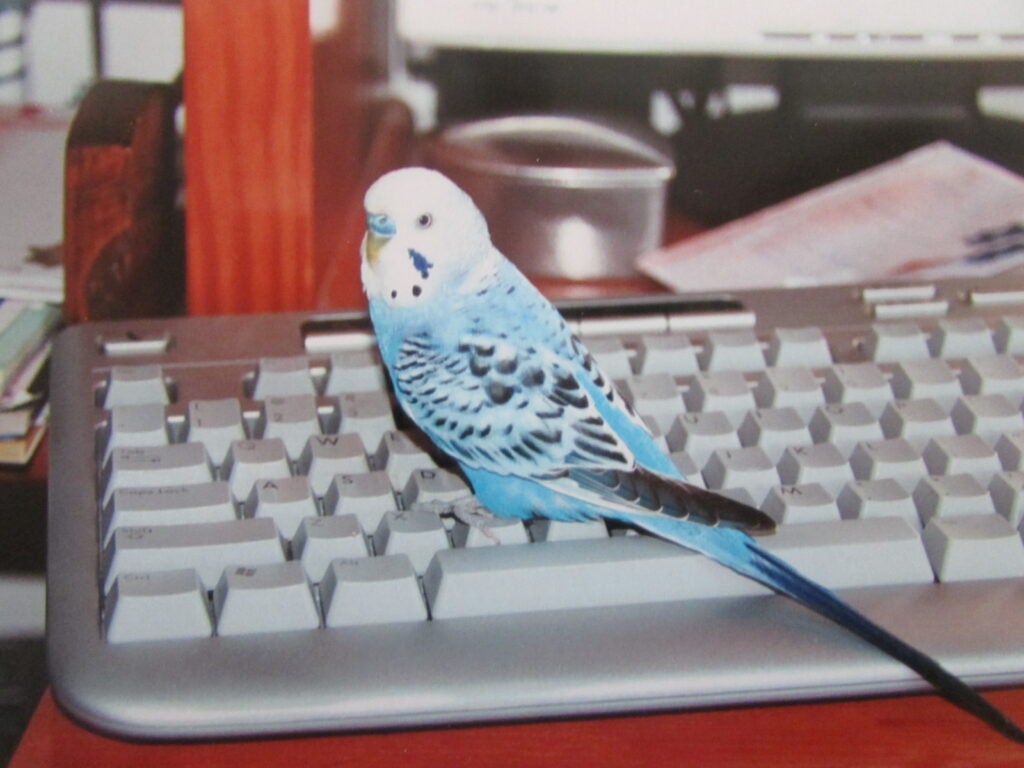Love Can Be Covered By Feathers
Published 12:30 pm Sunday, February 11, 2024
|
Getting your Trinity Audio player ready...
|
I look down at him and first carefully study his feathers. Chuck is a brilliant blue ball. A parakeet, full of energy and song, that is living in a purple cage on which the door is never shut because he has the run of the house.
I share my office with him. Amongst the books, papers and the computer, which are the furnishing in this room, are his toys. They are a necessity because he has an insatiable appetite for play things. They are arranged on a colorful vinyl throw which covers the top of the bed. This area consists of a Jungle Gym which my husband, Dale had made, a Merry Go Round of dancing mirrors that is also one of Dale’s creations and a perch that allows a giant view of the world outside my window. I call his space “Chuck Land”.
However, my feathered roommate, proves to be an enormous a distraction. For instance, I will be working on the computer when I feel a breeze from wings that are now fluttering above my head. Then, a little puff lands on my shoulder. Now, I hear a noise like a kiss that falls gently on my ear. When this happens, my heart melts and my train of thought dissolves. I know that I need to stop and pay attention to my little friend.
Chuck then flies down and lands in Chuck Land. A tiny foot comes up and it scratches a feathered head. Even this normal movement is something amazing to watch. Each day, each feather gets cleaned and covered with a special oil from a gland that is hidden under his tail feathers, in the back of his body. This oil is evident when he takes a bath because the water just rolls gently off of him. His feathers are also layered in a way to protect this tiny body that is made up of bones which are thin and hollow and add no weight at all. When he opens his little beak to yawn, then stretches his wings and feet, you know that only a Supreme Being could have conceived this precious form of life.
This little busy body also talks and talks and talks. He will tell you that he is Baby Chuck, and that he loves to give kisses, and now his speech is punctuated by him making a kissing sound. He also likes to dance and he calls it “bopping”. Now that he has your complete attention, he proceeds to play a game that he loves, “peek a boo”, with you.
As he talks on, and plays with his toys, I look down at him. I study his wings, his coloring and the unique design of his beak. What an exquisite creature. How can anyone doubt the existence of God, especially when viewing this tiny parakeet, a most delicate creation, as he talks and plays and swings upside down!
Originating in Australia, the parakeet was brought up to the United Kingdom around 1840, and quickly became a pet. When introduced into the United States, this colorful bird became known as a parakeet.
In the wild country of his native land, they are known as a “budgerigar”. The primary color of the feral bird is a light green and they can be found in flocks of thousands. The name, budgerigar, originates from the Aboriginal word, “betchegara”, which means food. Other names for his bird include, shell parakeet, because of the undulating markings on its wings. Another name is zebra parakeet, also because of the markings on these birds. It has stripes which appear on its head and shoulders. However, the more common name is grass parakeet because of its staple diet of eating grasses and similar vegetation.
Documentation shows the existence of a blue budgerigar and a yellow budgerigar that did exist in the wilds. These were mutations of the original and it is not known how this occurred. Since then, many mutations have appeared in those that are pets, with the first being the color blue. This color appeared in 1881, in Holland. From that initial sky-blue bird many variations have developed, including the cobalt, violet, mauve and slate. Later the grey appeared in this color group.
From the wild, normal green budgie, a yellow bird appeared in 1872. This was in Belgium. This bird led to new colors being added, such as olive, dark green and grey green. Additional varieties were soon developed by breeders. These were: those with a grey wing, and a light yellow or dark yellow popping out as a contrast color. Also appearing during this time were: light blues and a white mixtures. This first appeared in Australia in the 1880s, as a pet. Other forms of this color mixture appeared in Denmark and Holland around this time.
It wasn’t long after that a mutation known as the clear wing appeared. This is a form of a parakeet which had yellow wings and a yellow head with a green body. The blue form of this bird has white wings and a white head with a blue body. Both of the clear wings varieties have an absence of melanin in the feathers of the wings, head and tail. Also, it was during these days of mixing and matching colors that the albino appeared.
Luckily breeders of these birds kept excellent records and having a clean and disease-free place, kept the newly formed mutations exceptionally healthy. Now there are millions of breeders across the world, mainly in the United States, Britian and Australia.
I couldn’t find out when the first talking bird was found. However, I do know that in nature they live in colonies, busily chattering among themselves as they go about their daily activities. Pet budgies behave just like their cousins in the wild, although within much smaller boundaries and with humans as members of their flock. When kept in single or multiple pairs, the birds bond to one another and generally thrive within their own social circle. Budgies, unless regularly handled and integrated into family life, tend to prefer other birds to human company. However, a single parakeet will often bond closely to its owner, whether you have one bird or are caring for a small flock. You can enrich a parakeet’s life and stimulate its intelligence, when you pay a lot of personal attention to it and provide it with a room with a view. This tantalizes their instincts and their wonderment about the outside environment.
Even though my Chuck is small, his spirit is large. His happy song in the morning makes the day sunny even if its gray and his instincts are uncanny. When you talk to him, he knows it. His feathers will rise up and then ripple on what resembles a wave. Sometimes, he will step closer to your mouth and listen intently trying to absorb your sounds and imitate them. He does this especially when you use words that are not familiar to him.
How did this little birdie come to me and take over my house? Well, several years ago, I became very sick and was pretty much housebound. I wanted a pet to keep me company. Sadly, I am allergic to dogs and cats. Therefore, a parakeet was the perfect answer to my craving for the companionship of a pet.
I have had parakeets before, so I was familiar with their characteristics. Mostly, I wanted a male, which has a blue color above its beak and are the talkers. Unfortunately, the females like to just set and screech at you.
When I got to the pet store, there were so many birds to choose from that I just could not pick one. I wanted them all. I asked my husband, Dale, to pick one for me. He spotted that bright, royal blue male eating seeds like there was no tomorrow. Then, acting like he wanted to get our attention, began throwing the shavings from the bottom of the cage, all over. He was the runt of the flock, and what a sight, with his feathers sticking out all over his body. I looked at him and he looked my way. Our eyes connected and it was love at first sight.
On the way home, I asked Dale to help me name him. He said, “Let’s call him Chuck. He sure can chuck down them seeds!”.
Thus, Chuck came into our lives. He remained a runt. And was always busy following his male instincts. One was the building of a nest for his flock. To do this he chewed on strings. So, to help him fulfil this desire, I made him what I called a “mop” for his cage. It was about 20 strands of cotton string, some with beads on them. Every day he would chew on it. and it became all curly and twisted but to him it was his nest and his protection when he slept.
His flock consisted of many mirrors which dangled throughout the house and his cage. He also treats my husband and I, and every bird he sees outside, as if he were in charge of us all. He sets on the window sills and croons his song to his outdoor friends, then settles down on our shoulders and sings to us.
In the evening, before he goes to sleep, he does a fly by, which is the male way of protecting the flock. In these trips he is checking that there are not any threats nearby that may hurt us during the night. He takes his duty towards us very seriously and is vigilant about making sure all is safe. Sort of like a miniature Doberman pincer that has blue feathers.
Chuck falls in love with everything. One time, my chrome toaster was the object of his affection. He would stand in front of it and flap his wings to show his beloved that he has beautiful plumage. Next, he would sing the pretty songs that were interspersed with the words he had learned.
When taking his afternoon nap, he sometimes would set on my shoulder and cuddle his head to my chin or go under my collar. He loves it when I lift my shoulder and rub him against my cheek. He becomes all puffy and closes his eyes for a minute or two. When, he is revitalized, he is ready to play some more.
As small as he was Chuck knew he was Chuck. When I would call his name, he came flying and chirping. He would set on my head or on my shoulder and begins his chatter. So, when I was having a bad health day, he was there to entertain me with his antics. This never failed to pick up my spirits.
As we all know, life does come to an end. After having my dear Chuck for ten years, he passed away in my hand. I knew he was not well because he didn’t want to play and when he tried to fly, he would fall to the floor. I had talked to an avian veterinarian who told me that the average life of a parakeet is 5 to 7 years and my Chuck was 10, so I was blessed by having him longer than most.
I did ask Jesus not to let my feathered baby die alone or during the night. My prayers were answered when, while holding Chuck in my hand, close to my heart so he could hear it beat, he passed.
A pet, no matter how small, has a profound effect on our lives. They respond to our tender love and care by being our companion. If you cannot have a dog or a cat, I recommend a parakeet. It is not necessary that you let him be free, a nice size cage will suit him just fine. The folks at the pet store will help you with your selection. Also, they cost almost nothing to feed. A giant jar of seeds and some treats and he will be in heaven. However, he does require toys and your companionship. So, play with him and enjoy his antics. He will return your love by providing hours of fascinating entertainment.






